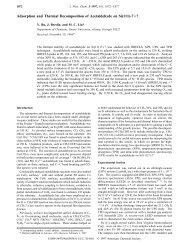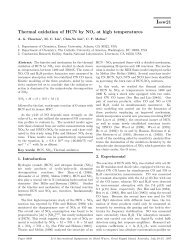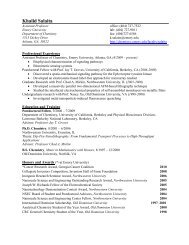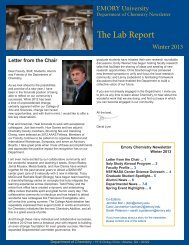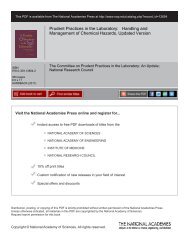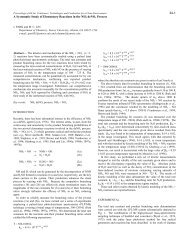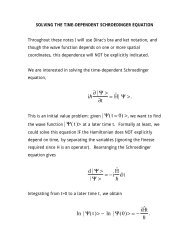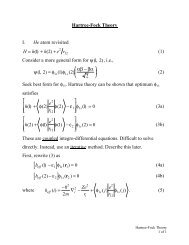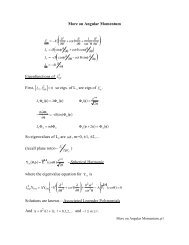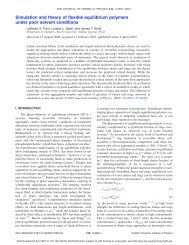The Lab Report - Chemistry - Emory University
The Lab Report - Chemistry - Emory University
The Lab Report - Chemistry - Emory University
You also want an ePaper? Increase the reach of your titles
YUMPU automatically turns print PDFs into web optimized ePapers that Google loves.
Letter from the<br />
Chair<br />
Dear Faculty, Staff, Students, Alumni<br />
and Friends of the Department of<br />
<strong>Chemistry</strong>,<br />
It has been far too long since we<br />
connected with the entire <strong>Emory</strong><br />
<strong>Chemistry</strong> Community and much has<br />
happened. Let me set the stage for<br />
things to come.<br />
When I arrived on the <strong>Emory</strong> campus just over 10 years ago, I saw<br />
a new model emerging, one focused on collaboration and excited<br />
about seizing opportunities created by scientific discovery. I was<br />
impressed by the early successes of this model, such as the <strong>Emory</strong>-<br />
Georgia Tech Biomedical Engineering program and a Science 2000<br />
initiative that brought many of <strong>Emory</strong>’s natural science departments<br />
together geographically. But most significantly, I was seduced by<br />
the diverse community of scientists that worked collaboratively for<br />
positive transformation and believed that anything was possible.<br />
This community, it appeared to me, had captured a new and unique<br />
strategy for a research university that I found truly remarkable.<br />
And in this collaborative community, I believe, lies <strong>Emory</strong>’s great<br />
strength and limitless potential. We are in a time where the<br />
connections between traditional units become as important as the<br />
units themselves and where our understanding of our world evolves<br />
at an ever-increasing pace. A case could be made that at no time in<br />
our intellectual history has academic research in chemistry been more<br />
central to societal sustainability than today. From chemical ecology<br />
and health sustainability to renewable energy, from emergent disease<br />
detection to the origins of life, from genomics, proteomics, and<br />
metabolomics to dynamic systems chemistry, from drug development<br />
and terrorists threat detection to the design of new materials, and<br />
from understanding Earth’s ocean floor to defining the composition of<br />
planets around other stars, chemical research provides the foundation<br />
from which technological development depends. Accordingly,<br />
the Department has diverged from the traditional sub-sections of<br />
chemistry to an agile and dynamic model for capturing emerging<br />
intellectual opportunities and several areas of shared scientific interest<br />
and distinction have been identified, including:<br />
• Catalysis and Sustainable Energy<br />
• Modeling and Computational <strong>Chemistry</strong><br />
• Molecular Building Blocks and Biomaterials<br />
• Molecular Evolution, Synthetic Biology, and Origins of Life<br />
• Synthesis and Drug Discovery<br />
Furthermore, all but the newest of these scientific initiatives (Molecular<br />
Building Blocks and Biomaterials) have attracted financial support for<br />
collaborative research center and one of them (Synthesis and Drug<br />
Discovery) is responsible for the discovery of a medicine that is taken<br />
EMORY <strong>University</strong><br />
Department of <strong>Chemistry</strong> Newsletter<br />
<strong>The</strong> <strong>Lab</strong> <strong>Report</strong><br />
Spring 2012<br />
by more than 90 percent of HIV/AIDS patients in the U.S. and around<br />
the world that are currently on medication.<br />
Our commitment to scientific and pedagogical innovation has<br />
contributed to the growth of a robust and dynamic <strong>Emory</strong> Science<br />
Commons. <strong>The</strong> adaptation of student-centered “problem-based<br />
learning” in the chemistry classroom has inspired new successes<br />
for students in several 1st and 2nd year courses. Collaborations<br />
between Departments continue to broaden the impact of the<br />
molecular sciences. <strong>The</strong> development of peer-to-peer learning<br />
opportunities, such as seen in ORDER (On Recent Discoveries by<br />
<strong>Emory</strong> Researchers), invites graduate students to teach their research<br />
using interdisciplinary methods. And opportunities to learn chemistry<br />
in the context of other disciplines have brought students together<br />
and extended <strong>Chemistry</strong> across our campus. “<strong>The</strong> <strong>Chemistry</strong> of Art<br />
Restoration” and a unique study abroad program with the <strong>University</strong> of<br />
Siena connects chemistry with art, architecture, food and wine.<br />
I feel especially lucky to lead a Department so dedicated to advancing<br />
<strong>Emory</strong>’s reputation as a great place to study, teach, and discover.<br />
Last year alone, members of the Department received the highest<br />
faculty honors awarded by the <strong>University</strong>, the Jefferson Award (Liotta),<br />
the <strong>Emory</strong> <strong>University</strong> Scholar-Teacher Award (Lynn), and the <strong>Emory</strong><br />
Williams Award for Distinguished Teaching (Weinschenk). And most<br />
importantly, the Department’s focused contribution of its IP settlement<br />
from Emtriva to the unified growth of the Science Commons will<br />
impact the entire <strong>University</strong> with its collaborative culture.<br />
I am confident in the future of the Natural Sciences within the College<br />
of Arts and Sciences, and <strong>Chemistry</strong> is beautifully positioned to blaze<br />
the pathway forward. We invite you to join us. Search our web page,<br />
follow us on Facebook and join our LinkedIn group. Keep in touch<br />
and come visit. We will certainly look forward to welcoming you (back)<br />
to our transformative Department that has grown so much from the<br />
foundations you all worked so hard to build.<br />
All the best,<br />
David Lynn<br />
<strong>The</strong> <strong>Lab</strong> <strong>Report</strong> Spring 2012<br />
Co-Editors<br />
Jennifer Bon • jbon@emory.edu<br />
Carol Jurchenko• cschum2@emory.edu<br />
Sarah Peterson • sarah.a.peterson@emory.edu<br />
Department of <strong>Chemistry</strong> • 1515 Dickey Drive • Atlanta, GA • 30322
Faculty Profile<br />
Dr. Chris Scarborough joined the<br />
<strong>Emory</strong> <strong>Chemistry</strong> faculty in Fall of<br />
2011. He earned his Ph.D. from<br />
<strong>University</strong> of Wisconsin-Madison<br />
in the lab of Shannon Stahl<br />
working on asymmetric catalysis of<br />
N-heterocyclic carbenes. He then<br />
worked as a post-doc at the Max<br />
Planck Institute in Germany studying<br />
chromium complexes with unusual<br />
electronic structures and analyzing<br />
them using various spectroscopies<br />
for paramagnetic transition metal<br />
compounds.<br />
Q: Why did you find chemistry<br />
interesting?<br />
CS: What I liked about chemistry…<br />
was that I could understand things at a very fundamental level, or at<br />
least at the time what I thought was a very fundamental level. I could<br />
draw organic reaction mechanisms that made sense. I could explain<br />
why these compounds form and why reactions go this way and that<br />
way and I really liked that. I love that in chemistry, you have the<br />
opportunity to make unique compounds with unique properties.<br />
Q: Why did you choose to focus on inorganic chemistry?<br />
CS: I looked around at some of the major homogenous industrial<br />
processes, like the Wacker oxidation, the LP Oxo Process, and the<br />
Monsanto and Cativa acetic acid processes, and thought that it was<br />
a bit silly that these use some of the rarest elements in the earth’s<br />
crust (and the most expensive, of course). Why do we have to use<br />
rhodium, iridium, and palladium? Why do they work and why do their<br />
abundant congeners, Ni and Co especially, why do these fail in these<br />
processes? I knew that to understand why, I had to learn about the<br />
electronic structure of these complexes.<br />
Q: If witness protection required you to make a career change…<br />
what would you pick as a second career?<br />
CS: I thought I might pick being an ambassador to a European<br />
country and live a good life, but I realized that if I’m under witness<br />
protection that’s probably a little too public! I always really loved<br />
history and if I hadn’t been good in science, I would have really<br />
enjoyed history, being a history major.<br />
Q: As a teacher, or in a political role?<br />
CS: I probably would’ve gone towards professorship and done<br />
research in history.<br />
Q: What was your favorite part of being a grad student or a postdoc?<br />
CS: My favorite part was the first two years of my Ph.D. and the first<br />
year of my post-doc. This is where the learning curve is so steep. It’s<br />
really…actually, it’s exhausting.<br />
<strong>The</strong> <strong>Lab</strong> <strong>Report</strong><br />
Spring 2012<br />
Q: That doesn’t seem like the good part! That’s the painful part.<br />
Everything fails; you don’t know anything; you don’t know what<br />
you’re doing!<br />
CS: (laughing) Yes, that’s right, but the amount that you learn when<br />
you’re on that steep part of the learning curve is just unbelievable.<br />
You start to see the world differently; you see everything through<br />
new eyes. <strong>The</strong>n once you level off and you start becoming highly<br />
productive now that you’ve learned this stuff, your world-view or your<br />
view of science isn’t changing so drastically but you’re generating<br />
interesting data. That’s fun as well, but I really love a good challenge.<br />
Q: What research is your lab focused on?<br />
CS: In some respects, I’m still intrigued by the same problem. Why<br />
are rhodium and palladium special in homogenous catalysis? I have<br />
a few things that I’ve learned that I think I could point to. <strong>The</strong>y’re all<br />
fundamental electronic structure things and so what we’re doing is<br />
we’re playing tricks, essentially, with the orbital shapes and sizes and<br />
electron interactions.<br />
Q: By playing with the ligands?<br />
CS: That’s right, by synthetic design. A lot of it is ground-state<br />
engineering. One of the projects we do is a photochemistry project,<br />
and I like to refer to that as excited-state engineering because we<br />
have to know all about the excited states and be able to tune them,<br />
which is not very easy. Tuning ground states is hard enough. <strong>The</strong><br />
major problem that we’re trying to solve is replacement of these<br />
precious-metal catalysts with earth-abundant catalysts.<br />
Q: Which chemist would you most like to see win the Nobel<br />
Prize?<br />
CS: That’s a hard question. I think if I had to pick someone it would<br />
be Harry Gray. He’s amazing, he’s a wonderful person, and his<br />
research has spanned a lot of different areas. He’s absolutely one<br />
of the founding members of inorganic chemistry in the last century.<br />
A phenomenal guy, phenomenal research…starting as a classical<br />
inorganic chemist and thinking about ligand field theory (he helped<br />
develop that theory, molding MO theory and crystal field theory) to<br />
develop our understanding of transition metal complexes. All the way<br />
to long-distance electron transfer in proteins, how biology deals with<br />
electron transfer. He’s pretty phenomenal and now he’s working on, of<br />
course, the energy problem, water splitting.<br />
Department of <strong>Chemistry</strong> • 1515 Dickey Drive • Atlanta, GA • 30322
Faculty Profile<br />
In August of 2011, Dr. Emily<br />
Weinert joined the faculty of<br />
the biomolecular division of the<br />
<strong>Emory</strong> <strong>Chemistry</strong> Department. Dr.<br />
Weinert earned her Ph.D. in 2006<br />
from the <strong>University</strong> of Maryland,<br />
College Park where she worked<br />
on synthesis of quinone methides,<br />
the basis of many anti-cancer<br />
drugs, in the lab of Steven Rokita.<br />
From there, she moved on to<br />
UC Berkeley to do a post-doc in<br />
the lab of Michael Marletta. Her<br />
post-doc work focused on heme<br />
proteins. She sat down to discuss<br />
with us a little about herself and<br />
her research here at <strong>Emory</strong>.<br />
Q: What made you decide to major in chemistry?<br />
EW: My dad’s a physicist. I grew up spending time thinking about<br />
‘here’s the natural world, what’s going on’ kind of questions…so I love<br />
science. And I just really like the molecular level understanding, trying<br />
to really understand. In college, I loved organic chemistry because<br />
once you understand what’s happening, it can be predictive. I love<br />
being able to do the experiments, have a prediction, go in test it and<br />
ask “Does that make sense?”.<br />
Q: What made you transition to biomolecular chemistry?<br />
EW: I’ve always really been interested in living systems and trying to<br />
sort out what’s happening in these complex systems. I had always<br />
hoped to get to the part in my Ph.D. (working with quinone methides)<br />
where we’d learned enough to go in vivo and test some of our<br />
theories. But like so often happens in science, sometimes you find<br />
that you really don’t understand things that well or you get drawn in<br />
different paths…so I wanted to do something more biological after<br />
focusing on small molecules.<br />
Q: Did you ever want to be anything else?<br />
EW: Actually, when I was growing up I wanted to be a wildlife<br />
biologist.<br />
Q: Really?<br />
EW: Yeah, live out in the wild and count the wolves and watch their<br />
migration patterns… But then I realized I didn’t really like the cold that<br />
much and living out in a tent with things that could eat me makes me<br />
a little nervous so I ran for the lab instead. I think it worked out a lot<br />
better.<br />
Q: And you have, like, you know…plumbing<br />
EW: Yeah, (laughs) that was another thing.<br />
Q: What research does your lab focus on?<br />
EW: My lab does protein chemistry. We’re interested in understanding<br />
how proteins work, thinking about them as complex chemical systems<br />
rather than as the normal circles and pac-men that we often see.<br />
<strong>The</strong> <strong>Lab</strong> <strong>Report</strong><br />
Spring 2012<br />
<strong>The</strong> two general interests in the lab are heme proteins and nucleotide<br />
signaling. We have some proteins that are heme proteins and<br />
some proteins that are involved in nucleotide signaling and at the<br />
intersection are a group of proteins that have both heme domains and<br />
do nucleotide chemistry. We’re looking at cyclic nucleotide signaling in<br />
bacteria and some potentially new cyclic nucleotides that are involved<br />
in pathways in mammals.<br />
We’re also interested in heme proteins and how protein scaffolds<br />
tune the electronics and the reactivity of the heme itself. A lot of<br />
heme proteins use protoporphyrin IX, although there are some other<br />
porphyrins, but you can take protoporphyrin IX and do chemistry with<br />
oxygen, like peroxidases and P450 enzymes. And you can also use<br />
the same porphyrin to do reversible ligand binding for oxygen delivery<br />
or for sensing. So organisms can actually sense gases, binding very<br />
low concentrations of ligand so that it causes a downstream change in<br />
the organism.<br />
Q: And this variation in activity is dependent on the protein<br />
structure?<br />
EW: Yes, the scaffold itself. So you can change the redox potential<br />
widely from around -400 mV to around 380 mV. That’s a huge change.<br />
You can change the type of reaction; you can change if you can do<br />
electron transfer with most of the biologically available oxidants and<br />
reductants. And so it can changes just about everything. And right<br />
now, our understanding of that is still pretty poor. <strong>The</strong>re’s a huge<br />
amount of work that’s been done on the globins. I think there are<br />
probably at least 150 mutants of myoglobin that have been published,<br />
but it’s still not very predictive and we can’t always apply it to other<br />
heme proteins. So, like most protein engineering or protein chemistry,<br />
we don’t have a lot of predictive power to suggest how mutations will<br />
affect the heme.<br />
Q: Which chemist do you wish you had an opportunity to meet?<br />
EW: Rosalind Franklin and Hans Fischer.<br />
Q: Why them?<br />
Rosalind Franklin has a fascinating story. <strong>The</strong> work she was doing<br />
was still in a time when it was not necessarily expected that many<br />
women did their own science. She was clearly brilliant and she figured<br />
out most of the structure of DNA before Watson and Crick. <strong>The</strong><br />
reason Watson and Crick got the structure was by looking at her data.<br />
Unfortunately she died before the Nobel Prize was given and they<br />
don’t give it posthumously. I think she would be fascinating to talk to<br />
and to hear her story.<br />
Hans Fischer was the first to discover chlorophyll and heme and<br />
he was the first one to figure out what these pigments were and to<br />
synthesize them. I think it’s really interesting to think of how do you go<br />
about, at the time (the 1920’s), saying ‘I’m going to isolate this colored<br />
compound’ and then how do you go about with the techniques then<br />
available figuring out what all is in there? I think it would be really<br />
interesting to hear how the field got started from the guy that started<br />
the field!<br />
Department of <strong>Chemistry</strong> • 1515 Dickey Drive • Atlanta, GA • 30322
C-H Center Prepares for Evaluation<br />
<strong>The</strong> NSF Center for Chemical Innovation on Selective C-H<br />
Functionalization has been very active this past year as it gears<br />
up for evaluation as a Phase II center. C-H functionalization, the<br />
conversion of C-H bonds into C-X bonds where X is any of a variety<br />
of heteroatoms or carbon, is widely recognized to have the potential<br />
to be transformative across chemical disciplines. Traditionally C-H<br />
bonds are very inert and therefore hard to activate; however, certain<br />
catalysts make this possible and can render C-H bonds a functional<br />
handle. Challenges remain in both regio- and stereoselectivity due<br />
to the small differences in C-H bond strengths. As general methods<br />
for the functionalization of specific C-H bonds are developed, these<br />
methods are becoming powerful due to the ubiquity of C-H bonds<br />
in organic, organometallic and biological molecules of interest.<br />
<strong>The</strong> Center’s mission focuses on the impact that this new mode<br />
of reactivity will have in material science, fine chemical synthesis<br />
and drug discovery in addition to the potential paradigm shift C-H<br />
functionalization could create in the way organic chemistry is taught.<br />
<strong>The</strong> initial Phase I Center involved 6 PI’s: the center director Huw<br />
Davies, Simon Blakey and Jamal Musaev at <strong>Emory</strong>, Justin DuBois at<br />
Stanford, Jin-Quan Yu at Scripps, and Christina White at <strong>University</strong><br />
of Illinois U-C. During Phase I, the Center has not only fostered<br />
numerous research collaborations but has facilitated a number of<br />
student exchanges and outreach programs. A Communicating<br />
Science course was offered in conjunction with the Center for<br />
Chemical Education in which graduate students from across the<br />
department practiced various methods of communicating with other<br />
scientists, students and the public. A Graduate School Prep/Journal<br />
Club was developed at Spelman College to help students prepare for<br />
and be successful in graduate school. <strong>The</strong> Center has also started an<br />
annual symposium on C-H Functionalization in order to engage the<br />
entire scientific community not just center members.<br />
In early March of this year, seven people from the <strong>Emory</strong> <strong>Chemistry</strong><br />
department (founding Center members Davies, Blakey and Musaev,<br />
students Felicia Fullilove, Slava Boyarskikh, and Jen Bon, and staff<br />
member Meisa Salaita) plus 13 other professors and students traveled<br />
to NSF headquarters in Arlington, VA for the Phase II evaluation. <strong>The</strong><br />
Phase II proposal expands the center to a total of 24 PIs from 16<br />
different universities and includes additional experts in the following<br />
areas:<br />
<strong>The</strong> <strong>Lab</strong> <strong>Report</strong><br />
Spring 2012<br />
• Total Synthesis: Erik Sorensen (Princeton), Mo Movassaghi<br />
(MIT), Brian Stoltz (Cal Tech), Richmond Sarpong (UC Berkley)<br />
• Methodology Development: John Montgomery (Michigan)<br />
• Catalyst Design: Cora MacBeth (<strong>Emory</strong>), Matt Sigman (Utah),<br />
Andy Borovik (UC Irvine)<br />
• Computational <strong>Chemistry</strong>: Ken Houk (UCLA)<br />
• Analysis of Reactive Intermediates: Donna Blackmond<br />
(Scripps), John Berry (Wisconsin), Dick Zaire (Stanford)<br />
• Flow Technologies: Chris Jones (Georgia Tech)<br />
• Material Science: Seth Marder (Georgia Tech), Stefan France<br />
(Georgia Tech), Christine Luscombe (Washington)<br />
If the Phase II grant proposal gets funded, $20 M over the next<br />
five years will be split between the 24 principal investigators and<br />
their labs. It would allow for continued outreach in many forms,<br />
including continuation of the Grad School Prep Club at Spelman<br />
and expansion to additional local universities and to schools located<br />
near other Center institutions as well. It would provide funding for<br />
a post-doctoral position in outreach that would include training in<br />
public communication in the form of blogging and animation. <strong>The</strong><br />
postdoc would also participate in the AAAS Mass Media Science and<br />
Engineering Fellowship Program during which they would work with<br />
a national media organization to communicate science to the public.<br />
With Phase II funding the Center would also work toward expanding<br />
undergraduate chemistry education to include covering more cutting<br />
edge techniques and reactivity including C-H Functionalization.<br />
<strong>The</strong> Center for Selective C-H Functionalization has already made an<br />
impact at <strong>Emory</strong> and beyond, both to advance this exciting field of<br />
research and to share it with both general and scientific communities.<br />
Department of <strong>Chemistry</strong> • 1515 Dickey Drive • Atlanta, GA • 30322
<strong>The</strong> Undergraduate Bulletin<br />
Ch<strong>Emory</strong> Highlights<br />
<strong>The</strong> 2011-2012 academic year was another busy and exciting year<br />
for Ch<strong>Emory</strong>, <strong>Emory</strong>’s undergraduate American Chemical Society<br />
(ACS) affiliated chemistry club. This club strives to raise awareness<br />
about chemistry in the broader university community and to promote<br />
sustainability.<br />
As part of their outreach efforts, Ch<strong>Emory</strong>’s demo team worked<br />
to kindle excitement about science and a passion for chemistry<br />
in the community. <strong>The</strong>y visit local elementary schools to perform<br />
demos, such as fake snow and the methanol canon, and to assist in<br />
interactive demos, like gloop and bubbles.<br />
In the fall, Ch<strong>Emory</strong> hosted a series of events bringing undergrads,<br />
grad students, and faculty together to celebrate National <strong>Chemistry</strong><br />
Week in October. <strong>The</strong> weeklong series of events included preparing<br />
a Periodic Table of Cupcakes, a demos show, and Mole Day party.<br />
Ch<strong>Emory</strong> members performed science demonstrations ranging from<br />
cool demonstrations with liquid nitrogen, brightly colored chemical<br />
rainbows, to the hot fiery thermite reaction. On Mole Day, revelers<br />
were treated to Minute-To-Win-It games and science-inspired<br />
music. <strong>The</strong> Mole Ball was dropped at precisely 6:02 pm, which<br />
was then followed by the ignition of three hydrogen balloons and<br />
the presentation of the Periodic Table of Cupcakes. In honor of the<br />
International Year of <strong>Chemistry</strong> and to welcome arrival of two new<br />
faculty members, a handmade mole-shaped piñata, dubbed “Dr. A.<br />
Mole,” was cracked opened to reveal sucrose-saturated treats.<br />
During the spring semester, Ch<strong>Emory</strong> celebrated Valentine’s Day<br />
by having a dress-up day, where members dressed as their favorite<br />
chemical pair, such as a diene and dienophile pair from the Diels<br />
Alder reaction, two components of an emulsion, and the dyes Cy3 and<br />
Cy5 from a FRET pair. In addition, the club was able to sponsor five<br />
members to attend the 243rd ACS National Meeting in San Diego,<br />
CA. <strong>The</strong> members participated in a chemistry demos exchange and<br />
presented a poster at the “Successful Chapter” event hosted by<br />
the Division of Chemical Education. <strong>The</strong> meeting was a wonderful<br />
opportunity for networking, getting exposure to new research and<br />
picking up free periodic tables of elements.<br />
As part of our green chemistry and sustainability mission, Ch<strong>Emory</strong><br />
also hosted green events that emphasized the integration of<br />
environmentally benign technology and materials into our daily<br />
lives, academia, and industry. Ch<strong>Emory</strong>, under the tutelage of Dr.<br />
Doug Mulford, held a balloon twisting class that used biodegradable<br />
latex balloons. Students left the event with armfuls of balloon<br />
poodles and flowers, and new knowledge about degradable plastics<br />
and recycling. Ch<strong>Emory</strong> also held a green study break, where<br />
students were introduced to the 12 Principles of Green <strong>Chemistry</strong>,<br />
as stated by the ACS Green <strong>Chemistry</strong> Institute®, and played with<br />
water-soluble starch-based toys, building unusual biodegradable<br />
structures. Collaborating with the Georgia local section of ACS,<br />
Ch<strong>Emory</strong> organized and hosted Dr. Bob Peoples, the Director of<br />
the ACS Green <strong>Chemistry</strong> Institute®, who gave a talk on the global<br />
perspective of green chemistry and its impact on society. In particular,<br />
he emphasized the effectiveness of green chemistry in industry<br />
through the development of green products and in the synthesis of<br />
pharmaceutical products.<br />
<strong>The</strong> <strong>Lab</strong> <strong>Report</strong><br />
Spring 2012<br />
Three <strong>Emory</strong> sophomores make peanut butter<br />
playdough at Mole Day festivities<br />
<strong>Emory</strong> College students put Mentos into a bottle<br />
of Coke to create enough volume for it to spill<br />
over in “Bubblin’ Over” (top). Dr. A. Mole”piñata<br />
(below.)<br />
Department of <strong>Chemistry</strong> • 1515 Dickey Drive • Atlanta, GA • 30322
Spotlight on the Graduate Program<br />
Student Profile: Michael Reddish<br />
Michael Reddish, a second year student in the Dyer Group, was<br />
awarded the prestigious National Science Foundation Graduate<br />
Research Fellowship for 2011-2014. <strong>The</strong> oldest fellowship of its<br />
kind, the Graduate Research Fellowship Program strives to select<br />
recipients whose academic and research history anticipates significant<br />
contributions to research, teaching, and innovations in science and<br />
engineering. <strong>The</strong> priorities outlined by the NSF highlight Reddish’s<br />
strengths and the value he brings to our department.<br />
Reddish graduated from Furman <strong>University</strong> in 2009. It was during<br />
a serendipitous summer research opportunity with his Physical<br />
<strong>Chemistry</strong> professor Jeff Petty that he found a scientific field that<br />
really resonated with his intellectual disposition. He had never been<br />
one to take answers at face value. Rather, he had always sought<br />
the how and why answers, recognizing the value of taking things<br />
and ideas apart to really understand them. As Reddish explains it,<br />
Physical <strong>Chemistry</strong> seeks to answer “How?” in order to understand<br />
“Why?” As a result, it requires a broad knowledge base, and what<br />
Reddish enjoys most about graduate school is being able to spend<br />
his days learning in a variety of disciplines - chemistry, physics,<br />
biology, math - and to approach<br />
his research through different<br />
means - programming, reviewing<br />
relevant literature, working on an<br />
instrument in the Physics machine<br />
shop, or collecting data in the<br />
Dyer lab.<br />
Reddish participates in the<br />
enzyme dynamics research<br />
of the Dyer lab, which aims to<br />
understand how enzymes function<br />
as reaction centers. He focuses<br />
on dihydrofolate reductase (or<br />
DHFR), which serves as a model<br />
enzyme because it is present in<br />
all living organisms and a building<br />
block for DNA. It is well studied, helping Reddish and his colleagues<br />
focus on their specific point of interest – the enzyme’s dynamic<br />
structure. Among other things, Reddish studies the hinge loop<br />
structure present in DHFR, an enzyme difficult to investigate because<br />
it operates on a very fast time scale. Once all the components are in<br />
place the reaction happens in roughly one millisecond. (Of course, the<br />
process of getting all the right players in place simultaneously has its<br />
own time scale.)<br />
A central component of work in the Dyer lab is choosing and adjusting<br />
instruments to allow for better observation of atomic motion at very<br />
fast time scales. One approach Reddish and his colleagues use<br />
to study the enzyme’s dynamic interactions is laser spectroscopy,<br />
which facilitates their observation of different areas in the enzyme’s<br />
structure. <strong>The</strong> specific properties of interest can be measured by<br />
laser probes that interact with emitted light directly by absorbing its<br />
energy and often re-emitting some of the energy as different light.<br />
<strong>The</strong>refore, Reddish must carefully design experiments by selecting a<br />
probe that will report on the area of interest and then using the correct<br />
instrument to observe its response throughout the reaction. If they<br />
can understand the enzyme’s structure and how it changes during a<br />
reaction, then they can better understand how it functions.<br />
<strong>The</strong> <strong>Lab</strong> <strong>Report</strong><br />
Spring 2012<br />
When describing how he goes about investigating the structure<br />
of DHFR, Reddish modestly suggests it is akin to fixing a vacuum<br />
using traditional problem solving techniques. By removing variables,<br />
one can begin to isolate what is essential to a system’s function.<br />
Reddish and his colleagues observe DHFR in its native state then<br />
alter its structure or introduce new variables to observe whether<br />
the reaction occurs identically. If something different or unexpected<br />
happens, then they try to identify what structural change might have<br />
contributed to the new result. As anyone who has tried to fix a broken<br />
machine knows, this method requires a lot of patience, focus, and<br />
determination, all qualities required of a <strong>Chemistry</strong> graduate student<br />
and qualities Reddish possesses in plenty.<br />
Looking ahead, Reddish aspires to a faculty position at a smaller<br />
institution where he can have greater impact on the community<br />
through science. He sees hope in the force of science education to<br />
act as a vehicle to greater prosperity by inspiring innovation, and he<br />
strives to contribute his passion and knowledge to that effort. We are<br />
fortunate to have Michael Reddish working toward his goals at <strong>Emory</strong>,<br />
and we are proud that the NSF Graduate Fellowship committee<br />
recognized his high quality work.<br />
Career Seminar<br />
In 2010, the <strong>Chemistry</strong> Department implemented a Career<br />
Development Seminar Committee aimed at growing the conversation<br />
about next steps for chemistry PhDs. <strong>The</strong> Seminar emerged from a<br />
Faculty retreat where two graduate student representatives articulated<br />
their concern about a perceived stigma around non-academic career<br />
paths. <strong>The</strong> feeling that choosing a career outside the academy may<br />
disappoint one’s mentor(s) is pervasive, and it can leave graduate<br />
students without knowledge of alternatives to the tenure-track and<br />
feeling unsure of how to make career decisions. Professor Susanna<br />
Widicus Weaver responded by leading a planning committee, made<br />
up of four graduate students – Kevin O’Halloran, Chandra Potter,<br />
Carol Schumacher, and James Simmons – who conducted an online<br />
anonymous survey to poll the <strong>Chemistry</strong> graduate students about<br />
their interests. <strong>The</strong>n they planned seminars and workshops geared<br />
towards the topics that garnered the most interest with two main<br />
goals: to present alternate career paths and to discuss common<br />
challenges to and best practices for building a successful career and<br />
work-life balance.<br />
<strong>The</strong> first event in September 2010 was a panel discussion made up<br />
of local individuals with backgrounds in <strong>Chemistry</strong> who have pursued<br />
different career paths: teaching faculty member, Professor Jack<br />
Eichler (formerly of Oxford College), a former government lab principal<br />
investigator, Professor Brian Dyer (<strong>Emory</strong>), a patent attorney, Patrea<br />
L. Pabst, J.D. (Pabst Patent Group); and an industrial chemist and<br />
<strong>Emory</strong> alum, Dr. Vladimir Gigoriev (Kemira). With over 70 students in<br />
attendance, the discussion was a huge success. After two and half<br />
hours of lively discussion, we had to take our last question (primarily<br />
because one of the panelists had a prior engagement!). <strong>The</strong> seminar<br />
filled a great need among our graduate students and invited them to<br />
pose questions they might otherwise have been hesitant to ask.<br />
Since then, thirteen professionals have presented at the Career<br />
Seminar Events, providing useful information about writing resumes,<br />
telling stories about the (often winding) paths they took to their current<br />
job, and offering valuable advice about job negotiations.<br />
Department of <strong>Chemistry</strong> • 1515 Dickey Drive • Atlanta, GA • 30322
Spotlight on the Graduate Program<br />
Career Seminar cont.<br />
Widicus Weaver and the planning committee have been successful<br />
in inviting people who have a wide range of stories and advice to<br />
share, which helps students feel more confident imagining how<br />
they might use their science degree. This year we heard from Prof.<br />
Steven Shipman, a professor at a liberal arts college, Dr. Eva Heintz,<br />
a technology manager at Solvay Specialty Plastics, Dr. Todd Polley,<br />
our own department’s Director of Operations, Lt. Col Brian Tom, an<br />
Air Force lieutenant, and Dr. Valerie Young, a well-known career<br />
consultant. While each speaker identified concrete approaches to<br />
the job market, they also offered personal stories and advice that<br />
emphasized the personal and sometimes unpredictable nature of a<br />
career path. Most students found comfort and inspiration in hearing<br />
that the trajectory of many successful chemistry PhDs is rarely straight<br />
or straightforward.<br />
<strong>The</strong> Career Seminar Committee is always<br />
looking for Friends of the Department who<br />
have stories to share.<br />
Even if you cannot come to campus,<br />
please let us know what you are doing<br />
and how you got there by sending a<br />
message through Facebook or email.<br />
Department of <strong>Chemistry</strong> • 1515 Dickey Drive • Atlanta, GA • 30322<br />
<strong>The</strong> <strong>Lab</strong> <strong>Report</strong><br />
Spring 2012
Alumni Reflection<br />
Malcolm Hendry MS48 PhD50<br />
After I spent 2 1/2 years in the navy, my young bride and I finished our<br />
bachelors degrees, mine as a chemistry major. But I didn’t feel I knew<br />
enough to be a real chemist. My adviser suggested several graduate<br />
schools for me to consider. I still had almost two years of GI bill<br />
remaining. After writing to each I set off to select a school. Having no<br />
money, I hitchhiked, not nearly so scary in 1947 because the public<br />
had picked up hitchhiking service men all during the war.<br />
My plan was to hitch to three graduate schools including <strong>Emory</strong>. I<br />
didn’t plan well, reaching Lookout Mountain in the middle of the<br />
night...but then a got a lift on down to Atlanta. When I walked onto the<br />
<strong>Emory</strong> campus and saw all those beautiful Georgia marble buildings I<br />
thought it was heaven. <strong>The</strong>y almost glowed in the sunlight.<br />
<strong>Emory</strong>’s chemistry graduate program was new with only about a<br />
dozen students. After meeting the chemistry faculty and determining<br />
our mutual interest it seemed that <strong>Emory</strong> was the place for me.<br />
But where would we live? Before the war it was unheard of for<br />
married couples to attend school so our next problem was living<br />
accommodations. <strong>Emory</strong> had provided for the deluge of married<br />
couples with trailers on campus and the tar paper covered army<br />
barracks on Clifton Rd soon to be known as “mudville”. We were<br />
assured of a one-bedroom apartment (at a cost of $17 per month,<br />
with army bunks and an ample supply of cockroaches).<br />
<strong>The</strong> chemistry department’s budget was very sparse in 1947. Vessels<br />
fitted with ground glass connectors were scarce. So we used rubber<br />
connectors. Potentiometers and heating mantles were given, one to<br />
each organic researcher. We made our own distillation columns from<br />
glass tubes filled with glass beads. Ground glass equipment gradually<br />
became available. Each of us had to build our own carbon/hydrogen<br />
analysis train to substantiate the new chemical compositions we were<br />
synthesizing.<br />
I began my masters research, on an organic chemical reaction<br />
involving bromine. <strong>The</strong> problem was the chemical hoods had no draft<br />
to draw off the fumes...so I ran a rubber tube out the window. <strong>The</strong><br />
clearest indicator of my research was the growing orange bromine<br />
stain on the outside marble window ledge.<br />
Our organic research labs were on the first floor, you know, one flight<br />
up the grooved marble steps, just below the analytical labs identified<br />
by the perpetual rotten egg odor.<br />
Our manometers were filled with mercury. And our stirrers were also<br />
sealed from air with mercury. As a consequence of these homemade<br />
devices there was always a puddle of mercury in the water troughs<br />
used to channel the cooling water from the distillation columns. No<br />
problem.<br />
<strong>The</strong> hood problem became more difficult during my doctorate<br />
research. <strong>The</strong> work involved butyric,<br />
valeric, and isovaleric acids (which smell like dirty socks, rancid<br />
meat and dog poop.) My wife always made me take off my clothes<br />
before entering the apartment and when I stood in a line at the store<br />
everyone began sniffing their arm pits and looking in every corner for<br />
a “deposit”<br />
My wife worked as a secretary to the <strong>Emory</strong> admissions director in the<br />
building next to the chemistry building. We walked back and forth to<br />
Mudville every day... until June 1950 when I finished my PhD<br />
<strong>The</strong> <strong>Lab</strong> <strong>Report</strong><br />
Spring 2012<br />
just as my GI bill ran out. It was the 5th PhD given by <strong>Emory</strong>. <strong>The</strong>re<br />
was just enough money left in our piggy bank to take the Greyhound<br />
to my new job in Ohio.<br />
Our years at <strong>Emory</strong> were Wonderful and life changing. Our greatest<br />
adventure!<br />
We are always eager to hear news from our<br />
alumni.<br />
Send your news.<br />
Share your stories.<br />
Find us on Facebook, LinkedIn, or email<br />
Department of <strong>Chemistry</strong> • 1515 Dickey Drive • Atlanta, GA • 30322
2012 Commencement<br />
<strong>The</strong> May 14th ceremony celebrated over 80<br />
<strong>Chemistry</strong> Majors. Congratulations and best<br />
wishes to our newest <strong>Chemistry</strong> Alums!<br />
SUMMER ‘11<br />
Hee Joo Choe<br />
Dua Ahmed Hassan<br />
Justiss Ailene Kallos<br />
Jalisha Denae Richmond<br />
FALL ‘11<br />
Xiaoying Gu<br />
Dylan Glenn Jones<br />
Yong Kim<br />
Sang-Jin Lee<br />
Yiwei Li<br />
Eric Robert Panicco<br />
Viet Xuan Tran<br />
SPRING ’12<br />
Nirja Jignesh Acharya<br />
Ayoka Masheila Adams<br />
Aneal A. Ahmed<br />
Ehiole Ogboma Akhirome<br />
Alexander Maximillian Baumgartner<br />
Anis Abdul Bhimani<br />
Andrew James Bowman<br />
Candace Kelly Bruney<br />
Kelly Suzanne Burke<br />
Alexander David Carstairs<br />
Su Jee Cha<br />
Charlene Jun-Zhi Chan<br />
Deep Dinesh Chandegara<br />
Edward Chen<br />
Wan-Hsuan Chen<br />
Yiwen Chen<br />
Marta M. Chlistunoff<br />
Myoung Jin Samuel Chun<br />
Amy Michelle Clark<br />
Katherine Elizabeth Conen<br />
Geraint Hywel-Madoc Davies<br />
Jeanne Rochelle Delgado<br />
Ian Samuel Diner<br />
Brent Garrison Earley Jones<br />
Benjamin Westley Euwer<br />
Kelly Christine Falls<br />
Yetunde Adekemi Fatade<br />
Emily Frances Fleischman<br />
Raphaela S Fontana<br />
Hamad Rafiq Ismail Hamad<br />
Jaeha Han<br />
Kevin Nicholas Harrell<br />
John Paul Haydek<br />
Ashley Sloan Hodges<br />
Jeremiah W. Huang<br />
Choon Sung Elizabeth Kambara<br />
Dipan Nishikant Karmali<br />
Hye Kyung Kim<br />
Hyun Woo Kim<br />
Clinton James Kimzey<br />
Jay Arthur Kroll<br />
Lee,Suk Young<br />
Amy Yan Li<br />
Hui Li<br />
Jacob George Light<br />
Christina Ann Liu<br />
Yuhong Liu<br />
Jared Curtis Malcom<br />
Victor-Alexandre Claude Mane<br />
Jordan Bennet Marks<br />
Stephen Sandell Marshall<br />
Richard William McLean<br />
Lauren Alyssa Newman<br />
Viva Bao Hoang Linh Nguyen<br />
Nawazish Ali Palejwala<br />
Akash Ashwinkumar Patel<br />
Parin Patel<br />
Rishi Ramesh Patel<br />
David Neal Primer<br />
Mary Lynn Radhuber<br />
Benjamin Joseph Redpath<br />
Alex Steven Rosner<br />
Mitchell Peter Rostad<br />
Andrew Charles Seidner<br />
Adam Thomas Stockhausen<br />
Petria-George Salewa Thompson<br />
Ying Kim Tsoi,<br />
Rahul Mahendra Varman<br />
Katherine Elizabeth Wagner<br />
Wei Wang<br />
Xinye Monica Wang<br />
LaCrystal Givens Ware<br />
Colin Vincent Washington<br />
Duncan Somerset Wood<br />
Suk Whan Yoon<br />
Phoebe Hope Young<br />
Guikai Zhang<br />
Tianyu Zhu<br />
Department of <strong>Chemistry</strong> • 1515 Dickey Drive • Atlanta, GA • 30322<br />
<strong>The</strong> <strong>Lab</strong> <strong>Report</strong><br />
Spring 2012
Faculty News<br />
Joel Bowman won the 2013 Dudley Herschbach award for “Bold<br />
Architectural Works Inspiring and Empowering in the field of the<br />
Dynamics of Molecular Collisions” and is currently serving as Vice-<br />
Chair of the PHYS division of the ACS. <strong>The</strong> Bowman group published<br />
several notable papers this year: “Dynamics of the O(3P)+CHD3(vCH<br />
= 0,1) Reactions on an accurate ab initio potential energy surface,” G.<br />
Czakó and J. M. Bowman, Proc. Nat. Acad. Sci, USA, in press (2012).<br />
“Intersystem crossing and dynamics in O(3P)+C2H4 multichannel<br />
reaction: Experiment validates theory,” B. Fu, Y.-C. Han, J. M.<br />
Bowman, L.Angelucci, N. Balucani, F. Leonori, and P. Casavecchia,<br />
Proc. Nat. Acad. Sci, USA, in press (2012). “Roaming reactions: <strong>The</strong><br />
third way,” J. M. Bowman and A. G. Suits, Phys. Today 64, 33-37<br />
(2011). And “Dynamics of the Reaction of Methane with Chlorine<br />
Atom on an Accurate Potential Energy Surface,” G. Czakó and J.<br />
M. Bowman, Science 334, 343-346 (2011) (Learn more about this<br />
research).<br />
Dennis Liotta received several awards in the last year, including the<br />
Uncommon Courage Award from Queens College and the Intellectual<br />
Property Legends Award from King and Spalding, Georgia State<br />
<strong>University</strong> College of Law and the J. Mack Robinson College of<br />
Business. He was named one of <strong>Emory</strong>’s 175 History Makers and<br />
received the “Significant Event of 2011” Award from the Office of<br />
Technology Transfer at their annual Celebration of Technology and<br />
Innovation. Liotta is now part of the ACS Medicinal <strong>Chemistry</strong> Hall of<br />
Fame, an ACS Fellow, and a member of the Cerecor Inc. Scientific<br />
Advisor Board.<br />
David Lynn and post-doc Jay Goodwin, at the request of NASA and<br />
the NSF, led an international group of scientists in workshop called<br />
“Alternative Chemistries of Life: Empirical Approaches” in Washington<br />
in April. More information.<br />
<strong>The</strong> Emerson Center director, Jamal Museav, Emeritus Professor<br />
Keiji Morokuma, and coworkers’ April publication in JACS on<br />
removal of aromatic and aliphatic thiols, sulfides, disulfides,<br />
thiophenes, etc. from mixture in crude oil by nano-scale Pd-catalyst<br />
for subsequent use in organic synthesis was highlighted by C&E<br />
News.<br />
Al Padwa has been awarded a Heilbrun Distinguished Fellowship by<br />
the <strong>Emory</strong> <strong>University</strong> Emeritus College for 2012-2013 in support of his<br />
work on finding “New Synthetic Routes toward Nigrogen Alkaloids.”<br />
His mobiles, which can be found throughout Atwood and Emerson,<br />
were featured in C&E Magazine in July.<br />
Khalid Salaita, graduate students Daniel Stabley, Carol<br />
Schumacker Jurchenko, and undergraduate Stephen Marshall<br />
(12C), published an article in Nature Methods on their discovery of a<br />
new method to measure the molecular tugs applied by cell surface<br />
receptors. <strong>The</strong> work was highlighted with a video depiction by C&E<br />
News, a Nature Methods author profile, and it was listed as one of<br />
the Top Ten Discoveries at <strong>Emory</strong> for 2011. This new technique is<br />
broadly useful for understanding how mechanical tugs can be used<br />
in cell to cell communication, which is generating excitement around<br />
its potential to facilitate investigation of how proteins function in<br />
cells. (Read more about it). Consequently, the lab received a 5 year<br />
R01 grant ($1.5 million) from the NIH National Institute of General<br />
Medical Sciences (NIGMS) to study the role of these tugs in the<br />
functions of the Notch pathway. <strong>The</strong> Notch pathway is very important<br />
in development and their dysfunction contributes to T-cell Acute<br />
Lymphoblastic Leukemia (T-ALL). <strong>The</strong> Salaita group bids farewell and<br />
<strong>The</strong> <strong>Lab</strong> <strong>Report</strong><br />
Spring 2012<br />
good luck to Stephen Marshall (12C) who is heading to Caltech to<br />
work on a PhD in <strong>Chemistry</strong>.<br />
Susanna Widicus Weaver received the Faculty Early Career<br />
Development (CAREER) Award from the National Science<br />
Foundation. Members of her group also received several awards,<br />
including Jay Kroll (12C) who received the distinction of highest<br />
honors fro his undergraduate research; James Sanders (14C) was<br />
awarded the <strong>Emory</strong> <strong>Chemistry</strong> Early Career Research Achievement<br />
Award; and doctoral candidate Jake Laas was awarded an <strong>Emory</strong><br />
<strong>University</strong> <strong>Chemistry</strong> Quayle Research Fellowship.<br />
Jeremy Weaver was one of two faculty in <strong>Emory</strong> College to be<br />
named “Honor Council Faculty Advisor of the Year. ”<br />
Student News<br />
Congratulations to graduate student Ana West (Kindt group)<br />
for winning the poster prize sponsored by the journal Soft Matter<br />
for “Effects of Defects on Stress Relaxation in Self-Assembled<br />
Protein Networks” at the 2011 International Symposium on Stimuli-<br />
Responsive Materials.<br />
Clay Owens (Blakey group) was awarded an Amgen graduate<br />
internship.<br />
Tony Prosser (Liotta group) received an NSF Graduate Fellowship<br />
for 2012-2015.<br />
Jordan Sumliner (Hill group) was selected for a Curriculum<br />
Development Fellowship through the Center for Science Education<br />
and Howard Hughes Medical Institute (HHMI).<br />
Felicia Fullilove and Katie Chepiga (Davies Group) were selected<br />
to participate in the Center for Science Education Problems and<br />
Research to Integrate Science & Mathematics (PRISM) Program<br />
beginning this summer. <strong>The</strong>y will be working with Atlanta middle/high<br />
school teachers to develop and implement innovative K-12 lessons<br />
into their curricula.<br />
Phoebe Young (12C) was awarded a Fulbright Fellowship to support<br />
her first year of study at the Friedrich-Schiller Universität in Jena,<br />
Germany. She will be working on a Masters in Chemical Biology with<br />
a focus on optimizing mass spectrometry imaging to answer questions<br />
about metabolite function on plant surfaces in the context of chemical<br />
ecology. She also received the “Excellence in Undergraduate<br />
Research” Award<br />
10 of our 2012 <strong>Chemistry</strong> Majors will be attending top research<br />
programs this Fall:<br />
<strong>University</strong> of Pennsylvania<br />
Geraint Davis (12C)<br />
David Primer (12C)<br />
<strong>University</strong> of Colorado-Boulder<br />
Jay Kroll (12C)<br />
California Institute of Technology<br />
Kelly Burke(12C)<br />
Stephen Marshall (12C)<br />
Harvard <strong>University</strong><br />
Charlene Chan (12C)<br />
Georgia Institute of Technology<br />
Duncan Wood (12C)<br />
Hye Kyung Kim (12C)<br />
Department of <strong>Chemistry</strong> • 1515 Dickey Drive • Atlanta, GA • 30322
Student News cont.<br />
Undergraduate Awards<br />
Excellence in <strong>Chemistry</strong><br />
Charlene Chan (12C)<br />
Excellence in Undergraduate Research<br />
Phoebe Young (12C)<br />
Excellence in Undergraduate Educational Support<br />
Boru Wang<br />
Bhavesh Patel<br />
Samantha Green<br />
Outstanding 1st year <strong>Chemistry</strong> Student<br />
Zonair Khan<br />
Early Career Achievement Research Grant<br />
James Sanders<br />
Hypercube Outstanding Physical <strong>Chemistry</strong> Student<br />
Kelly Burke (12C)<br />
Undergraduate Research Symposium Poster Awards<br />
1st prize: Kelly Burke (12C)<br />
Excellent: Matthew Birnbaum<br />
Kevin Harrell (12C)<br />
Duncan Wood (12C)<br />
Graduate Awards (Read more about these awards)<br />
ARCS (Achievement Rewards for College Scientists)<br />
Danny Mancheno (Blakey group)<br />
Johnston Award<br />
Teddy Huang (12G)<br />
Lester Awards<br />
Yajing Lian (12G)<br />
Quayle Fellowships<br />
Haiming Zhu (Lian group)<br />
Jake Laas (Widicus Weaver group)<br />
Yoshie Narui (Salaita group)<br />
Aidi Kong (Blakey group)<br />
Changming Qin (Davies group)<br />
Outstanding TA Awards<br />
Neha Ahuja (MacBeth group) - Gen Chem <strong>Lab</strong><br />
Jake Laas (Widicus Weaver group) – Pchem <strong>Lab</strong><br />
Jason Bothwell (Scarborough group) – Organic <strong>Lab</strong><br />
Alumni News<br />
<strong>The</strong> <strong>Lab</strong> <strong>Report</strong><br />
Spring 2012<br />
Lingfeng Liu (09G) who is currently a postdoctoral fellow in Wendell<br />
Lim’s lab at UCSF, received research fellowship from the Cancer<br />
Research Institute.<br />
Erika Milczek (10G) will be completing her postdoctoral training in<br />
John Groves’ laboratory in the Department of <strong>Chemistry</strong> at Princeton<br />
in May and has accepted a position in the Biocatalysis Division at<br />
Merck in Rahway, NJ. She will begin her new position in June.<br />
Scott Davis (90G) is currently serving as Sr Vice Provost and Dean of<br />
Graduate Studies at Mercer <strong>University</strong> in Macon, GA.<br />
Obituary<br />
We send condolences to Hilda Razzaghi (03OX, 04C, 07G) for the<br />
tragic death of her husband Dr. Payman Houshmandpour in April and<br />
to the family of Mickea Rose (07G) who died in February.<br />
We are also saddened by the recent death of former <strong>Chemistry</strong><br />
Professor Larry Clever who died May 15th at his home in Atlanta.<br />
Prof. Clever joined the department in 1954 and retired in 1992.<br />
Stay in touch.<br />
Keep us updated<br />
Facebook, LinkedIn, or email<br />
Department of <strong>Chemistry</strong> • 1515 Dickey Drive • Atlanta, GA • 30322
2011-2012 Graduates<br />
*August 2011 **December 2011<br />
Mark Baillie** (Liotta Group)<br />
Dissertation: Towards the Development of Non-Toxic <strong>The</strong>rapeutics in<br />
the Fight against Cancer<br />
Spandan Chennamadhavuni (Davies Group)<br />
Dissertation: Synthesis of Small Molecule <strong>The</strong>rapeutics Utilizing<br />
Rhodium Carbenoid <strong>Chemistry</strong><br />
Teddy Huang** (Lian Group)<br />
Dissertation: Charge Transfer Dynamics in Homogeneous and<br />
Heterogeneous Artificial Photosynthetic Systems<br />
Haipeng Hu* (Liotta Group)<br />
Dissertation: Validation of ReceptorBased Drug Design and<br />
Applications in the Study of IKKs, Truncated Taxane, and LRH-1<br />
Yajing Lian** (Davies Group)<br />
Dissertation: Rhodium Catalyzed Asymmetric Transformations of<br />
Vinylcarbenoids<br />
Yi-Han Lin* (Lynn Group)<br />
Dissertation: <strong>The</strong> Broad-Host Range Pathogenesis of Agrobacterium<br />
tumefaciens: Successful Coupling the Motions and Domain<br />
Interactions within Vira to Integrate Signal Sensing<br />
Yichen Liu* (Lutz Group)<br />
Dissertation: Engineering Kinases for Dual Thymidine and<br />
Thymidylate Kinase Activity<br />
Yue Liu (Lynn Group)<br />
Dissertation: Comparing and Contrasting Two Plant Pathogens<br />
Provides a Unique Window into the Differences in the Innate Immune<br />
Responses between Dicots and Monocots<br />
Mi-Sun Kim (Liotta Group)<br />
Dissertation: I. Design of a Novel Class of Reversible Non-Covalent<br />
Small Molecule Inhibitors for Human Granzyme B (hGrB); II. Curcumin<br />
and Mimics as Proteasome Inhibitors; III. Design of Novel Coactivator<br />
Binding Inhibitors (CBIs) for the Estrogen Receptor α: Break the 1μM<br />
Barrier<br />
Samantha Adkins Radford (Ryan Group)<br />
Dissertation: Degradation of Insecticides in Food and Beverages:<br />
Implications for Risk Assessment<br />
Melissa Ann Patterson** (Conticello Group)<br />
Dissertation: Synthesis of Protein-Based Polymers with the Potential<br />
to Form Physically and Covalently Cross-Linked Networks<br />
Weilin Peng (Conticello Group)<br />
Dissertation: I. Expanding Genetic Code in S. cevevisiae with an<br />
Orthogonal tRNA Trp/UCA/Tryptophanyl tRNA Synthetase Pair; II.<br />
Synthetic Yeast Prions Based on a Non-NQ-Rich Amyloidogenic<br />
Sequence Derived from the NAC Protein Sequence of α-Synuclein<br />
<strong>The</strong> <strong>Lab</strong> <strong>Report</strong><br />
Spring 2012<br />
James Austin Simmons** (Lynn Group)<br />
Dissertation: Conformational Exchange: A Common Mechanism for<br />
Amyloid Assembly<br />
Jie Song* (Hill Group)<br />
Dissertation: Exploring Catalytic Properties of Polyoxometalates in<br />
Aerobic Oxidation and Water Oxidation<br />
Colleen Knight Reynoso (Gallivan Group)<br />
Dissertation: Development and Application of Synthetic Riboswitches<br />
as Tools to Study Bacterial Pathogenesis<br />
Fuchang Yin*(Kindt Group)<br />
Dissertation: Simulations of Lipid Sorting Effects near Transmembrane<br />
Peptide<br />
Department of <strong>Chemistry</strong> • 1515 Dickey Drive • Atlanta, GA • 30322



